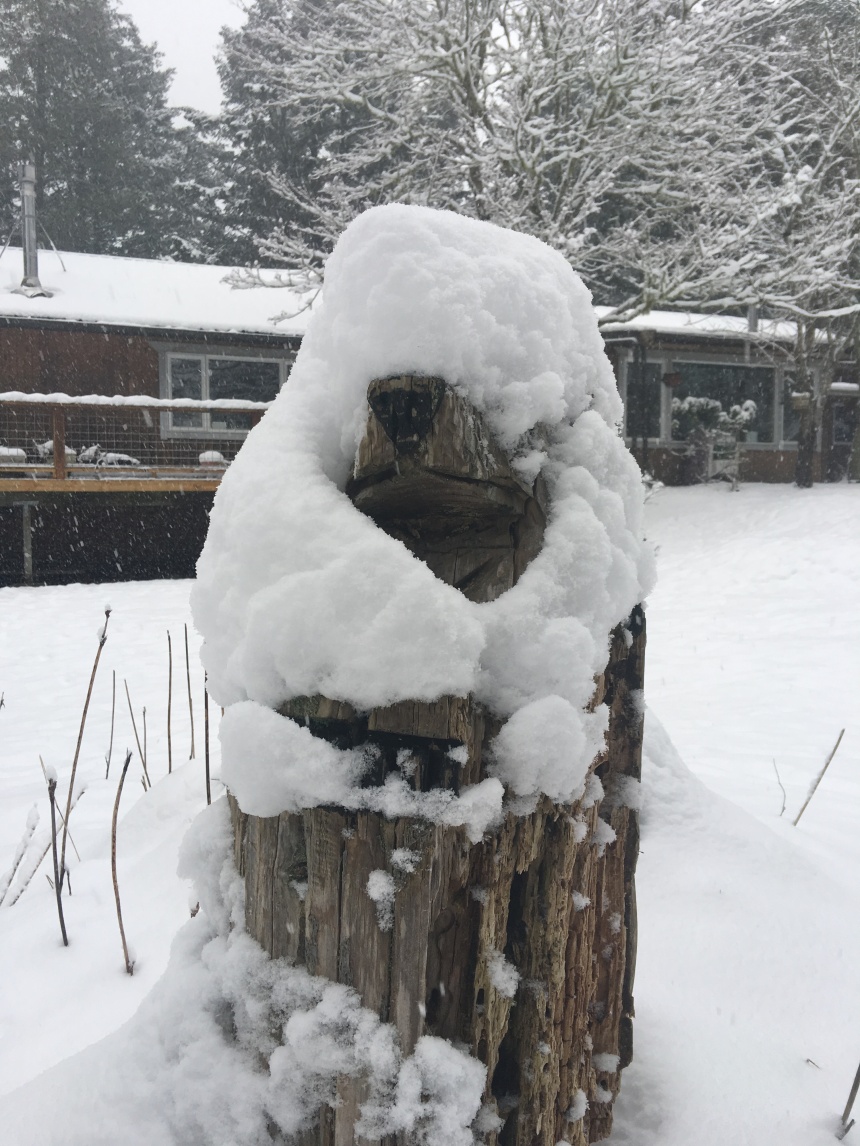Winter Crane Fly
It snowed on San Juan Island this week. We were forecast to have LOTS of rain yesterday, but instead we got more snow. So much snow that this former Texas gal just had to get out and experience the magic of our wooded, winter wonderland.

I got my coat, hat, and boots on, grabbed my iPhone and a pair of gloves, wrapped a scarf around my neck and set off to walk down our lonely country road.
Hoping to photograph some of our year-round feathered residents, I had my camera phone in hand. It was really cold outside and yet I couldn’t use the touchscreen wearing my glove. Off it came. I could sacrifice cold fingers if I could get a shot of one of the woodpeckers or maybe a Varied Thrush.
Heading down the driveway, I noted the way the limbs of the cedars and firs bowed down under the weight of the snow. Beneath them, little birds scurried, scratching about in the damp humus or flitting about on lower branches, enjoying a protected shelter from the cold. It took only a moment to spy a Dark-eyed Junco near the house on a leafless limb of our cherry tree and the Varied Thrush perched just above my head…perhaps waiting to see if I brought more seed out for them.

Dark-eyed Junco (Junco hyemalis)

Varied Thrush
A bit further down the driveway, I smiled when I saw our little carved bear. He’s not long for this world. The carpenter ants and the damp weather are slowly turning him into sawdust….but he rallied under his snow blanket today even though his little black nose was about all you could see.

Snow Bear
Wait…isn’t this post about a Winter Crane Fly? Well, I’m getting to that part. I certainly wasn’t anticipating seeing any invertebrates out on a day like this. While I’ve heard of snow fleas (not really fleas, but tiny invertebrates known as collembolans or springtails) or snow scorpionflies (Boreus spp.) found in winter in our forested area, I’ve yet to see them. It’s really a mystery how so many of these tiny creatures survive the extreme temperatures, but that’s also what makes them so interesting.
I came across the first of about ten of these tiny, winged “cranes” before I’d made it far down the road.

Winter “Crane”
We live in a somewhat densely forested area. Not many houses or development to interfere with the important ecological processes going on in the natural world. At first, it appeared to be a mosquito. Go figure. Somehow they thrive in Alaska, Minnesota, even the Arctic…in spite of frigid temperatures!
Looking closer, I speculated it was in the family Tipulidae, a common, but harmless, mosquito-looking, awkward flying, long-legged fly! I had to do some research to figure it out. The Tipulids are a genus in the insect order (Diptera) and commonly called “Crane Flies.” However, a bit of digging into the literature proved I was close to my ID of this creature, but not quite there.
What I discovered is that this is indeed a Crane Fly, but not a Tipulid. It’s a WINTER Crane Fly in the genus Trichoceridae. They are found flying on “warm sunny afternoons in fall, winter, and spring in the contiguous U.S., including Alaska and Canada” (Pratt 2003). In his study, Pratt (2003) observed specimens “swarming above or on the snow in temperatures between 0℃ and 10℃.” Maybe “warm” is subjective here!
This tiny Winter Crane Fly is very similar to the Tipulids or True Crane Flies with its long slender legs, but it differs in classification because the Winter Crane Fly has three ocelli (https://www.amentsoc.org/insects/glossary/terms/ocelli) or simple eyes that act as light sensors and are found on top of the head. The larvae of Trichocerid flies develop in the moist humus and decay of the forest floor and undoubtedly play some ecological role in this environment i.e. in decomposition or nutrient recycling. At a minimum, they are a nice protein-rich winter meal supplement for the little birds I’ve seen on my walk today.
While I’m not certain of the exact species, in the article by Pratt (2003), adults of one species, Paracladura trichopera, are found flying even in winter in British Columbia, Washington, Oregon, and California. Perhaps it will suffice to say that I was intrigued at the cold-hardiness of such a tiny creature. And I DO like the name, Winter Crane Fly!

Winter Crane Fly Trichocerid spp.
References:
1. The winter crane flies of North America north of Mexico (Diptera: Trichoceridae)
Pratt H.D. 2003. Proc. Entomol. Soc. Wash. 105: 901-914. http://www.biodiversitylibrary.org/page/16212448
